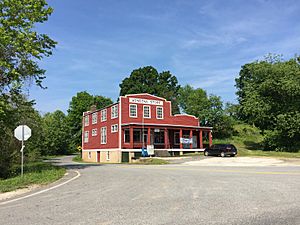Wingina, Virginia facts for kids
Wingina is a small place in Nelson County, Virginia, United States. It's called an unincorporated community, which means it's a group of homes and businesses that isn't officially a town or city with its own local government. It's located right by the James River.
Contents
A Look Back: Wingina's History
Who Lived Here First? Native Americans
Long, long ago, for at least 500 years before Europeans arrived, the Monacan and Mannahoac tribes lived in this part of central Virginia. They were Native American groups who settled along rivers like the Rappahannock River and the James River. As more English settlers moved into Virginia, the Native Americans moved to other areas.
In the 1800s, many Monacans created a new home at Bear Mountain in Amherst County. Many of their descendants still live there today. Other tribes like the Saponi and Tutelo are also part of this larger group of Native Americans.
Early European Settlers and Land Grants
The area where Wingina is located was once part of a huge land grant given to Dr. William Cabell in 1735. King George II gave him about 25,000 acres of land! The first Europeans to settle here called the area "Hardwicksville."
Wingina is south of Lovingston. It sits on James River Road (SR 56) right where the James River Bridge crosses the river. There was also a railroad station here, known as Wingina Station. The Wingina Post Office and a general store are still important parts of the community.
Ancient Trails and Roads
About five miles from Wingina, heading towards the town of Shipman, you'll find Glade Road. This road was also known as Secretary's Road or "Warriors Path." It was an important trail used by Native American groups like the Monacan and Powhatan Confederations. They used it for hunting and sometimes for war between different tribes.
This path started as a narrow dirt trail made by Native Americans walking in single file. Over many years, their footsteps wore a deep, narrow path through the wilderness. As more European settlers arrived, this trail was made wider. African slaves helped to widen and maintain the road so that horses, oxen, and later stagecocoaches and wagons could use it.
Bridges and Railroads: Connecting Wingina
In 1853, a company owned by Joseph Carrington Cabell built a covered wooden bridge over the James River at Wingina. This bridge was used during the American Civil War. Later, the Confederate army burned the bridge to stop General Sheridan's army from crossing. This was part of an effort to cut off General Lee's retreat.
In 1880, a railroad company called the Richmond Allegheny Railroad bought land around the canal. They named this area "Wingina" after a Native American chief from the 1500s. This chief, named Wingina, had resisted the arrival of Europeans in his lands.
In 1890, the Chesapeake and Ohio Railway (C&O) took over the property. In 1905, they built a strong steel bridge over the James River. They used the original stone supports from the older wooden bridge.
The Wingina General Store and Post Office
In 1920, the Johnson family moved to Wingina from Buckingham County. They opened the Wingina General Store and Post Office. This store was very important because it supplied the wooden railroad ties for the C&O railroad. John Yarborough was the first postmaster. The general store closed in 1991, but the post office still serves people in Wingina, Norwood, and Buckingham areas.
Historic Places in Wingina
Two important historic homes in the Wingina area are listed on the National Register of Historic Places. These are Edgewood and Soldier's Joy. Being on this list means they are special places that are important to the history of the United States.


